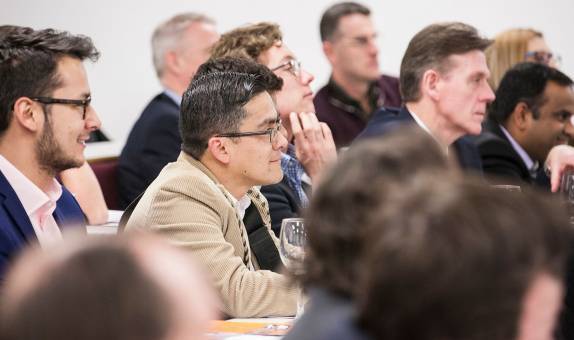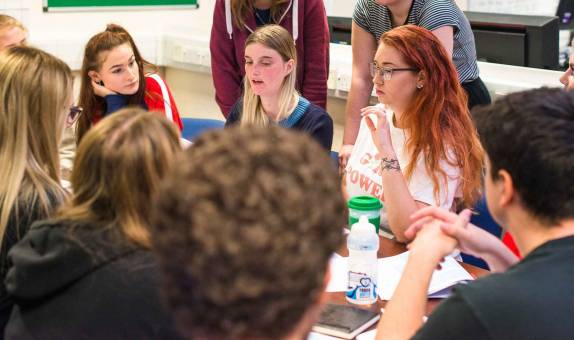Topic: Donor-centric philanthropy and marketing
Supervisors: Dr Rita Kottasz and Roger Bennett
This project responds to a call for a more systematic Investigation of donor-centric philanthropy: the interaction between situational (priming) and personal variables within the prosocial domain. This study will involve the building of a framework that explains how priming factors and a variety of individual characteristics jointly influence prosocial decision-making. Hypotheses derived from the framework will be tested via the utilisation of experiments. Using the latest data analytical techniques, the intention here is to get closer to understanding who gives, why they give, and how they can be cultivated to give more, for longer. Such insights will aid non-profit marketers in the successful recruitment and retention of donors.
Topic: Fanship, post-series depression and marketing
Supervisors: Dr Rita Kottasz and Professor Chris Hand
Post-series depression (PSD) describes feelings of melancholy and longing that can occur when an individual's all-consuming film or entertainment experience comes to an end. PSD, an entirely original scale and theoretical construct, developed by Kottasz et al (2019) is directly relevant to the entertainment, leisure and tourism industries. At the theoretical level, PSD integrates concepts of depression, emptiness and sad melancholy; however, this integration was not previously subject of prior academic research. The first few studies into PSD confirm links with fanship, compulsive buying practices, binge consumption, and theories of addiction. The scale will be useful for investigating the marketing implications of fanship, its connections with addictive behaviour and the emotional timing practices of commercial organisations. There are many opportunities to continue developing this scale in an inter-disciplinary setting.
Topic: Cross-selling marketing and future gazing for the arts
Supervisors: Dr Rita Kottasz and Professor Chris Hand
Project Outline: This research will examine how arts and cultural organisations have adapted their marketing initiatives during and after the Covid-19 crisis. In particular, the research will investigate the cross-selling of (i) virtual performances and exhibitions, and (ii) other events and products, during the pandemic. These extra marketing activities have continued as the pandemic declines and will constitute a permanent feature of the marketing portfolios of numerous arts and heritage venues. The research will analyse how specific configurations of organisational structure and managerial instruments affected cross-selling performance.
Topic: The use of poverty porn in charity advertising
Supervisors: Dr Rita Kottasz and members of the Kingston University Behavioural Lab
Project Outline: The purpose of this experimental research is to examine, via eye tracking and facial expression technologies, donor attitudes to fundraising advertisements that included poverty porn. Recently, charity advertising depicting poverty porn have been scrutinised and criticised by the media and publics. The central concern is that such charity imagery and advertising is a consequence of white saviourism and serves to promote philanthropic ‘racism'. It is suggested by some that post-colonial ‘helping cultures' of the West are tainted by power wielding and control. It is argued that the use of disaster pornography or poverty porn is a manifestation of unconscious bias and a desire for control. The research will explore the interplay between race, philanthropy, and fundraising. For background information, see the Journal of Philanthropy and Marketing's special Issue on Mapping the Intersection between Race, Fundraising and Philanthropy.
Topic: Disintermediation of the Charity Sector: implications for marketing
Supervisors: Dr Rita Kottasz
Project Outline: For decades, non-profit and voluntary sector organisations have acted as the intermediaries between donors who want to contribute money to help a cause and the beneficiaries of a cause. The non-profits would be responsible for marketing, fundraising, choosing the appropriate beneficiaries to help, monitoring the giving, and often delivering the service to beneficiaries. Recently, however, there has been a rise in individuals taking matters of altruism and fundraising into their own hands, thereby increasing the risk that the charity sector could become the next victim of disintermediation. Via the use of experiments, this research will explore one or more of the following issues:
- How do components of trust (integrity and competence) affect donor behaviour in the regulated fundraising space versus the unregulated fundraising space (personal/direct crowdfunding)?
- Does ‘proximity' (physical and emotional distance) build perceptions of trust and perceptions of impact?
- Does collaboration (with trusted partners) build a perception of trust and fundraising income?
- How does donor dominance and sense of agency impact on donor behaviour?
Topic: Understanding the impact of visual Word of Mouth (WOM)
Supervisors: Rahul Chawdhary and Francesca Dall'Olmo Riley
Word of Mouth (WOM) is widely acknowledged as a principal consideration behind 20% to 50% of all purchase decisions (Bughin et al., 2010). WOM has been largely researched either in its verbal form, which is also referred as face-to-face WOM, or in its written form which is known as online or e-WOM. However, visual WOM has received scant research attention. Visual WOM is typically considered as a sub-set of e-WOM and is defined as visual information presented through an image or video that offers pictorial representation of a product or service (Kim and Lennon, 2013). Increasing adoption of image based online platforms such as Instagram by customers to report their experiences with products and services in general, and tourism destinations in particular, merits an understanding of visual WOM.
The proposed project complements and extends existing research strengths in the domain of WOM within the Customer Insights and Value Research Hub.
Topic: Vertical extensions: consumer evaluation and feedback effects
Supervisors: Francesca Dall'Olmo Riley and Ceyda Payda Turan
There has been extensive research on brand extensions, but less so on vertical extensions, that is line extensions at a lower (downscale extensions) or higher (upscale extensions) price than the ‘normal' range of products sold under a brand name. For example, we do not know the effect of vertical extensions of different magnitude on extension evaluation and on the brand image. Consideration of price differentials of different magnitude could establish, for instance, the existence of any threshold effects in the evaluation of vertical extensions of brands with different position on the price/ prestige spectrum.
In the context of vertical extensions of brands with different positions on the price/ prestige spectrum, the effect of the product category (e.g. more conspicuous versus less conspicuous product categories) and of the brand logo visibility (or brand prominence) could be studied. Indeed, prior research by Dall'Olmo Riley, Pina and Bravo (2013) found evidence of interaction effects between the position of a brand on the price/ prestige spectrum and the product category on the value perceptions, extension attitude and purchase intention of vertical extensions. However, further research needs to substantiate and extend these findings.
Finally, the type of brand (e.g. service or luxury), the consistency of brand elements (e.g. similar versus different packaging), previous experience with the product category and ownership (or usage) of the brand may be factors affecting the evaluation of vertical extensions and the post-extension image of the parent brand.
The research will build upon several published studies on brand extensions conducted within Kingston Business School Customer Insights and Value Research Hub, examining the impact of parent brand characteristics, extensions type, country and product category on consumer perceptions.
Topic: Brand alliances
Supervisors: Francesca Dall'Olmo Riley and Ceyda Payda Turan
Introduction of new lines (e.g. Coca-Cola light, Colgate toothpaste for children) or brands (e.g. financial services by Sainsbury, men's grooming by Harley-Davidson) are widely adopted extension strategies. Compared to single brand strategies, collaborations between two or more brands represent an alternative strategy designed to take advantage of complementarities and inter-brand synergies. Probably the most widely-quoted example is between Dell and Intel while recent efforts include Apple and Nike (Apple Watch Nike+) and GoPro and Red Bull (GoPro:Red Bull Stratos). The latter are examples of brand alliances which Simonin and Ruth (1998, p. 30) define as 'brand alliances involve the short- or long-term association or combination of two or more individual brands, products, and/or other distinctive proprietary assets.' Attitudes towards and product and brand fit between the parent brands are, probably, the most extensively-researched aspects of brand alliances.
Areas that merit further research include: (i) reconceptualisation of the product and brand fit constructs, exploring further which dimensions of 'fit' other than 'brand image' and 'product category' should be considered when choosing the appropriate partner for an alliance; (ii) differential behaviour of value dimensions in forming perceptions of product fit and as determinants of evaluations of brand alliances; (iii) factors influencing the consumer evaluation of brand alliances in B2C vs. B2B markets and in alliances between online and offline brands; (iv) the impact of a firm's positioning on consumer acceptance of ingredient branding.
Research on brand alliances at Kingston Business School is well established, with a successful track record of PhD theses completion and journal publications.
Topic: Regulatory Focus Theory (RFT) and Mood
Supervisors: Chris Hand, Rahul Chawdhary and Helen Robinson
Combining self-discrepancy theory with questions surrounding hedonic motivation, Higgins (1997) developed the Regulatory Focus Theory (RFT). RFT deals with strategic issues related to how individuals pursue goals designed to align themselves with their desired goals or standards. RFT proposes two strategic and motivational orientations: promotion and prevention. Promotion focus relates to the pursuit of 'ideals' and is characterised by eagerness in the attainment of positive outcomes while prevention focus relates to the pursuit of 'ought' and is associated with vigilance and emphasises minimization of losses and avoidance of mismatches. Reviewing evidence, Boesen-Mariani, Gomez and Gavard-Perrett (2010) accordingly title their paper as 'Regulatory Focus: a Promising Concept for Marketing Research'. Amongst other marketing phenomena, RFT is found to provide answers to questions related to interpersonal differences in advertising persuasiveness. Specifically, evidence suggests that when advertisements account for elements that match (fit), individuals' orientation, advertising persuasiveness increases (Avnet and Higgins, 2006). Accordingly, advertisements focusing on achievements are more 'effective' when addressed to promotion orientated individuals while advertisements that emphasise security and safety appeal more to an audience that is prevention orientated.
Considering the fundamental role of mood in advertising there is evident lack of research that examines the role of mood as an enhancing mechanism in the creation of regulatory fit.
PhD research on RFT at Kingston Business School is ongoing.
Topic: Challenges and benefits of incorporating digital technologies in marketing activities
Supervisors: Ceyda Paydas Turan
In many organisations, business models have shifted from supply to demand as many large organisations (e.g. Amazon, Google, Netflix and Facebook) have personalised the customer experience and have reset customer expectations. While large organisations are pioneering artificial intelligence (AI) for marketing to meet the need of their customers, others may find the implementation of AI to be challenging and requiring a radical change in their internal processes. Yet, it is logical to assume that the early adoption of digital technologies such as AI would help organisations to figure out how to leverage it, and to better predict what customers are expecting. Human capacity to respond to the changing new business environment, where one-to-one personalised marketing is expected in various aspects (e.g. product customisation, advertising, promotions, pricing), may soon be inefficient and insufficient to serve customers in an increasingly complex environment. Therefore, it is important to address the challenges organisations face when incorporating digital technologies into their marketing activities. It is also important to justify the effectiveness of this radical change in organisations that decide to adopt AI. A mixed research approach, combining both qualitative (e.g. interviews with marketing managers) and quantitative methods (e.g. quasi-experimental design) will be employed to address the following research questions: What challenges do organisations (and their brands) face when incorporating digital technologies (e.g. AI) into marketing activities and how can they address these challenges? What are effective ways of using digital technologies in increasing brands' customer-centricity and building market share? The findings will have implication for theory and for practice.
Topic: Creating value through the transforming power of digital technologies
Supervisors: Ceyda Paydas Turan and Psychology, Organisational Behaviour or Computer Science Supervisor
Emerging digital technologies (e.g. artificial intelligence, augmented reality, virtual reality, mixed reality) are increasingly used by firms to achieve competitive advantage. However, digital technologies entail both benefits (e.g., customer empowerment, liberating for employee) and threats for their employees (e.g. uncertainty, fear of being replaced) and customers (e.g. dehumanisation, social deprivation). If the drawbacks of digital technologies are not well addressed by firms, the investment into digital technologies will not pay back. To turn the challenges into opportunities for competitive advantage and growth, firms need to have deep understanding of the impact of digital technologies on both their employees and customers. Therefore, firms adopting these technologies need to understand thoroughly both employee and customer attitude and behaviours toward digital technologies and how digital technologies transform the ultimate customer journey and experience. There is a paucity of comprehensive research that explores this topic from an interdisciplinary perspective. This PhD research project calls for candidates who are interested in a Marketing PhD topic that also crosses the disciplines of Psychology, Organisational Behaviour and Computer Science.

















